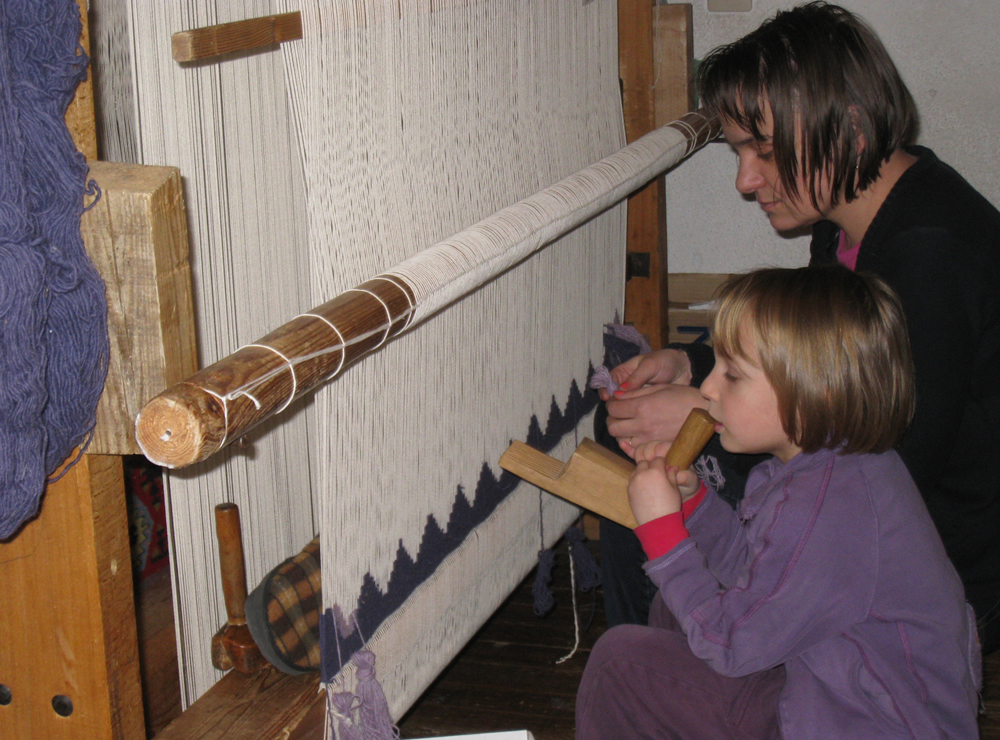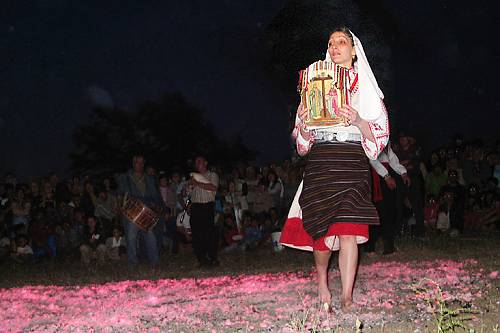Visoko multipart singing from Dolen and Satovcha, South-western Bulgaria
Visoko is a traditional practice of multipart singing that is unique to the Bulgarian villages of Dolen and Satovcha in the Blagoevgrad region. There are three types of multipart songs typical of Visoko: low-pitched, high-pitched and a combination of the two. Low-pitched singing consists of sustained singing by two vocal parts. High-pitched singing also includes two vocal parts, but is characterized by repeated outcries from both voices, an octave above the basic tone. These outcries are followed by a downwards slide and a recitative uttering of the lyrics in the low register. The third type of Visoko song entails a combination of low-pitched and high-pitched singing, with all four vocal parts. Visoko lyrics typically evoke nature. In the past, visoko songs, also known as summer songs, were sung outdoors by women working in the fields. While hoeing or harvesting, a group of women called out Visoko songs from one field, and a second group replied from another. Today, the main performers of Visoko are women and girls in singing groups from community centres in the two villages. This high-pitched multipart singing is a key identity marker for the Dolen and Satovcha communities. It is a cherished tradition that distinguishes them from neighbouring villages.

 Bulgaria
Bulgaria
Visoko multipart singing from Dolen and Satovcha, South-western Bulgaria
Date of Inscription :
Inscribed in 2021 (16.COM) on the Representative List of the Intangible Cultural Heritage of Humanity
Cultural practices associated to the 1st of March
Cultural Practices Associated to the 1st of March comprise traditions transmitted since ancient times to celebrate the beginning of spring. The main practice consists of making, offering and wearing a red and white thread, which is then untied when the first blossom tree, swallow or stork is seen. A few other local practices also form part of a larger spring celebration, such as purification actions in Moldova. The artefact is considered to provide symbolic protection against perils such as capricious weather, with the practice ensuring a safe passage from winter to spring for individuals, groups and communities. All members of the communities concerned participate, irrespective of their age, and the practice contributes to social cohesion, intergenerational exchange and interaction with nature, fostering diversity and creativity. Informal education is the most frequent means of transmission: in rural areas, young girls are taught how to make the thread by older women, while in urban areas apprentices learn from teachers, craftspeople and through informal education. Another occasion for transmission is provided by Martenitsa/Martinka/Mărţişor workshops organized by ethnographic museums. The communities concerned are actively involved in efforts to inventory, research, document and promote the element, and numerous cultural projects geared at its safeguarding are underway.
 Bulgaria
Bulgaria
Cultural practices associated to the 1st of March
multinational application of Bulgaria, Republic of North Macedonia, Republic of Moldova, Romania
Date of Inscription :
Inscribed in 2017 (12.COM) on the Representative List of the Intangible Cultural Heritage of Humanity
Bulgarian chitalishta (cultural community centres)
Bulgarian chitalishta (cultural community centres) are uniformly distributed across the whole territory of Bulgaria. They are established by communities themselves and are open to everyone irrespective of age, gender, political and religious views. The first chitalishta were established in 1856, and they have been recognized as a key organizational unit of Bulgarian society ever since. In accordance with the Chitalishta Act of 1996, chitalishta are non-governmental self-regulatory organizations. By law, they perform cultural and educational activities aimed at safeguarding the customs and traditions of Bulgarian people, ensuring access to information, distributing knowledge and familiarizing citizens with the values and achievements of science, arts and culture. Chitalishta are central to the process of transmitting intangible cultural heritage in the country, with elderly members playing a key role in encouraging young people to get involved. The efficiency of chitalishte is demonstrated by their increasing numbers over the years and the growing numbers of participants in their activities, representing all ages and population groups. With a view to popularizing and presenting intangible cultural heritage, chitalishta organize festivals, celebrations, gatherings, exhibitions and so on, and one innovative approach for developing chitalishta is the establishment of local centres for documenting, archiving and handing over knowledge and skills.
 Bulgaria
Bulgaria
Bulgarian Chitalishte (Community Cultural Centre)
Date of Inscription :
Selected in 2017 on the Register of Good Safeguarding Practices
Festival of folklore in Koprivshtitsa: a system of practices for heritage presentation and transmission
The concept for the Festival of Folklore in Koprivshtitsa, where thousands of Bulgarians of all ages and the diaspora meet in August to present and share their intangible cultural heritage practices ranging from dance and storytelling, to games and craftsmanship, originated when local musicians saw a need to protect traditions endangered by factors such as urbanization and commodification. Hosted by the Koprivshtitsa municipality with assistance from the Ministry of Culture, Bulgarian National Television, Bulgarian National Radio, the Institute of Ethnology and Folklore Studies with the Ethnographic Museum, the Institute for Art Studies and community centres, the festival raises awareness about the importance of safeguarding living heritage and promotes its presence in people’s lives, documents it for future continuity and stimulates transmission. Performers are nominated through selection procedures organized by Bulgaria’s administrative districts where new traditions are also identified, then performances broadcasted and documented by scholars for archival records such as those at the Institute of Ethnology and Folklore Studies with the Ethnographic Museum. Since the first festival in 1965, nine editions have taken place with 18,000 performers participating in 2010, attracting visitors from throughout the country and abroad. Many festival performers go on to become known internationally.
 Bulgaria
Bulgaria
Date of Inscription :
Selected in 2016 on the Register of Good Safeguarding Practices
Surova folk feast in Pernik region
The Surova folk feast in Pernik region takes place each year on 13 and 14 January to celebrate the New Year according to the old calendar. The core of the celebration is a popular masquerade ritual performed in villages throughout the region. On the first night, Survakari masquerade groups, consisting of men, women and children, don specially prepared masks and costumes and head towards the village centre where they light fires, and tease and play with the watching audience. Some participants adopt special roles, such as the leader, the newly-weds, the priest and the bear. Early the next morning, they gather and walk throughout the village visiting houses, where they ritually marry young couples while the bear ‘mauls’ people for good health. Hosts await their arrival with a ritual meal and gifts. After the folk feast, the Survakari distribute the gifts, often donating collected funds to orphans and poor people. The masquerade experience appeals to young people and raises their self-esteem as continuers of the tradition. Whole families engage in collecting materials for the masks and the other attributes during that entire year, with adults teaching young people and children how to make the distinctive masks and costumes.
 Bulgaria
Bulgaria
Surova folk feast in Pernik region
Date of Inscription :
Inscribed in 2015 (10.COM) on the Representative List of the Intangible Cultural Heritage of Humanity
The tradition of carpet-making in Chiprovtsi
Kilimi are hand-woven carpets made by the women of Chiprovtsi in north-western Bulgaria. Almost every household in the town contains a vertical handloom, which the women use to make two-sided carpets. The weaver takes several threads of the warp with her left hand, interlaces the weft yarn into the warp and uses a small beater to tighten the weave. The men of the town typically engage in wool production, processing and dyeing. Naturally dyed yarn gives soft pastel carpet hues, while chemical dyes produce brighter shades. The finished carpets are renowned for their composition, ornamental motifs and colour. Carpet weaving goes hand in hand with beliefs, verbal formulae and ritual practices. The weavers say prayers and make wishes for success before starting a new carpet, and sing and tell stories while working at the loom. The process of transmission occurs informally from mothers and grandmothers to daughters, often while working together on large carpets. Carpet weaving is deeply integrated into the social and cultural life of the population. The best-known forms of ornamentation are reproduced throughout the community and even constitute the coat of arms of the town.
 Bulgaria
Bulgaria
The tradition of carpet-making in Chiprovtsi
Date of Inscription :
Inscribed in 2014 (9.COM) on the Representative List of the Intangible Cultural Heritage of Humanity
Nestinarstvo, messages from the past: the Panagyr of Saints Constantine and Helena in the village of Bulgari
The Nestinarstvo fire-dancing rite is the climax of the annual Panagyr ritual on the feast days of Saints Constantine and Helena (3 and 4 June) in the village of Bulgari, in the Mount Strandzha region of south-east Bulgaria. The ritual is held to ensure the well-being and fertility of the village. In the morning, consecrated and ceremonial rituals are solemnized and a procession with the sacred icons representing the two Saints travels outside the village to a spring with holy water, accompanied by drum and bagpipes. At the spring, holy water and candles are handed out to everyone present for good health. The festival culminates in a fire-dance in the evening as the highest form of veneration of the Saints. People silently form a circle around the burning embers led by the sacred drum, and the Nestinari, who are spiritual and physical leaders through whom the saints express their will, begin entering the circle and treading the embers. Formerly celebrated in some thirty nearby Bulgarian and Greek villages, Nestinarstvo remains today in Bulgari, a village of only a hundred persons. During the Panagyr, however, thousands crowd the village, including in recent years many Greeks who join the ritual.
 Bulgaria
Bulgaria
Date of Inscription :
Inscribed in 2009 (4.COM) on the Representative List of the Intangible Cultural Heritage of Humanity
Bistritsa Babi, archaic polyphony, dances and rituals from the Shoplouk region
he traditional dances and polyphonic singing found in the Shoplouk region of Bulgaria are still performed by a group of elderly women, the Bistritsa Babi. This tradition includes diaphony, or what is known as shoppe polyphony, ancient forms of the horo chain dance and the ritual practice of lazarouvane, an initiation ceremony for young women. Diaphony is a specific type of polyphonic singing in which one or two voices build the melody consisting of izvikva meaning “to shout out” and bouchi krivo meaning “crooked rumbled roars”, while other singers hold a monotone drone that is doubled or trebled to produce a more sonorous sound that accompanies the lead singers.The dancers, dressed in traditional costumes, hold each other by the waist or belt and dance in a circle, stepping lightly and moving counter-clockwise. A number of variations are performed within this structure, depending on the song and ancient ritual purposes. Although the social function of the polyphonic singing has changed over the twentieth century, as it is now primarily performed on stage, the Bistritsa Babi are regarded as an important component of the region’s cultural life, promoting traditional expressions among the younger generations. The women are among the few remaining representatives of traditional polyphony and the village of Bistritsa is one of the last areas in Bulgaria in which this cultural expression has been maintained over the centuries. Due to its location near the capital Sofia, which offers a range of cultural attractions, young people’s interest in communitybased traditions is declining. Over the years, the rich repertoire of songs and dances has been reduced to include only the most popular highlights to be performed on stage.
 Bulgaria
Bulgaria
Bistritsa Babi, archaic polyphony, dances and rituals from the Shoplouk region
Date of Inscription :
Inscribed in 2008 (3.COM) on the Representative List of the Intangible Cultural Heritage of Humanity (originally proclaimed in 2005)







